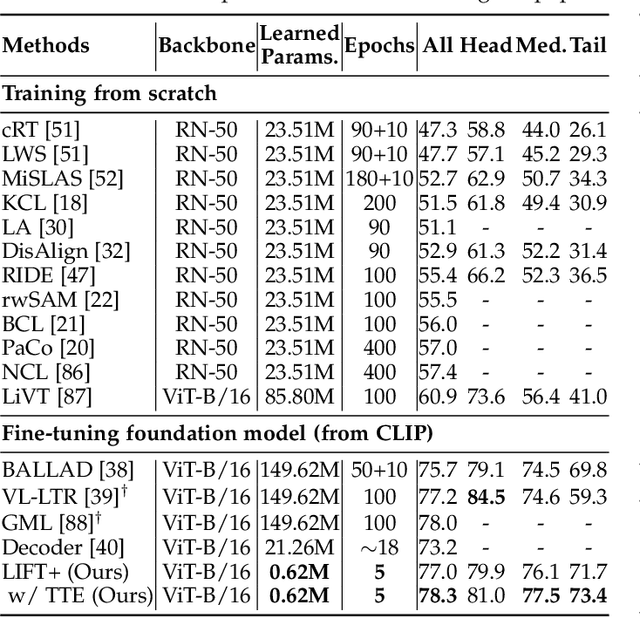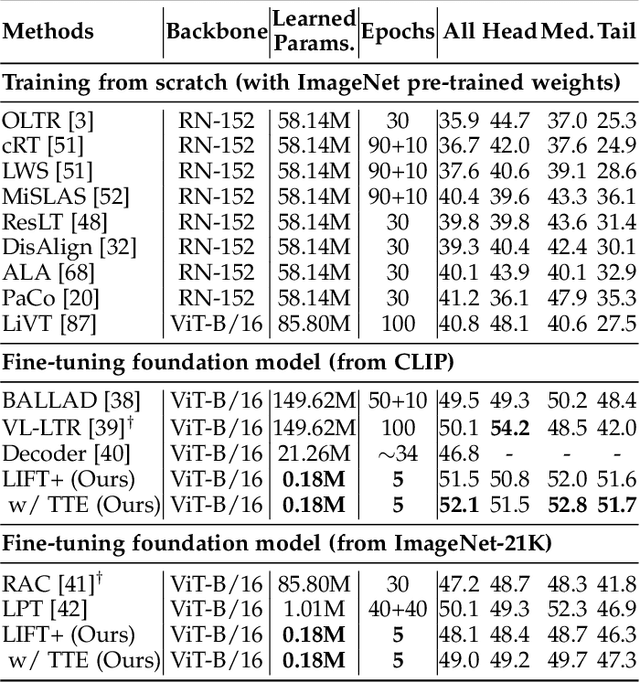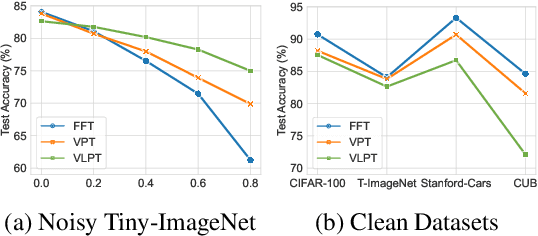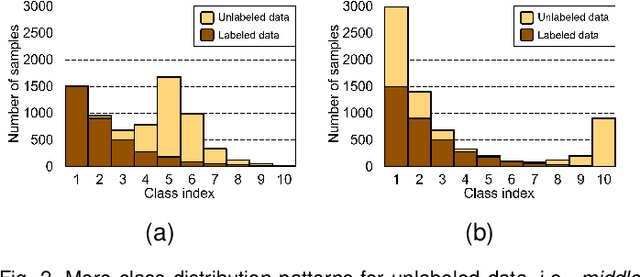Tong Wei
Tuning the Right Foundation Models is What you Need for Partial Label Learning
Jun 05, 2025Abstract:Partial label learning (PLL) seeks to train generalizable classifiers from datasets with inexact supervision, a common challenge in real-world applications. Existing studies have developed numerous approaches to progressively refine and recover ground-truth labels by training convolutional neural networks. However, limited attention has been given to foundation models that offer transferrable representations. In this work, we empirically conduct comprehensive evaluations of 11 foundation models across 13 PLL approaches on 8 benchmark datasets under 3 PLL scenarios. We further propose PartialCLIP, an efficient fine-tuning framework for foundation models in PLL. Our findings reveal that current PLL approaches tend to 1) achieve significant performance gains when using foundation models, 2) exhibit remarkably similar performance to each other, 3) maintain stable performance across varying ambiguity levels, while 4) are susceptible to foundation model selection and adaptation strategies. Additionally, we demonstrate the efficacy of text-embedding classifier initialization and effective candidate label filtering using zero-shot CLIP. Our experimental results and analysis underscore the limitations of current PLL approaches and provide valuable insights for developing more generalizable PLL models. The source code can be found at https://github.com/SEU-hk/PartialCLIP.
LADA: Scalable Label-Specific CLIP Adapter for Continual Learning
May 29, 2025Abstract:Continual learning with vision-language models like CLIP offers a pathway toward scalable machine learning systems by leveraging its transferable representations. Existing CLIP-based methods adapt the pre-trained image encoder by adding multiple sets of learnable parameters, with each task using a partial set of parameters. This requires selecting the expected parameters for input images during inference, which is prone to error that degrades performance. To address this problem, we introduce LADA (Label-specific ADApter). Instead of partitioning parameters across tasks, LADA appends lightweight, label-specific memory units to the frozen CLIP image encoder, enabling discriminative feature generation by aggregating task-agnostic knowledge. To prevent catastrophic forgetting, LADA employs feature distillation for seen classes, preventing their features from being interfered with by new classes. Positioned after the image encoder, LADA prevents gradient flow to the frozen CLIP parameters, ensuring efficient training. Extensive results show that LADA achieves state-of-the-art performance in continual learning settings. The implementation code is available at https://github.com/MaolinLuo/LADA.
LIFT+: Lightweight Fine-Tuning for Long-Tail Learning
Apr 17, 2025



Abstract:The fine-tuning paradigm has emerged as a prominent approach for addressing long-tail learning tasks in the era of foundation models. However, the impact of fine-tuning strategies on long-tail learning performance remains unexplored. In this work, we disclose that existing paradigms exhibit a profound misuse of fine-tuning methods, leaving significant room for improvement in both efficiency and accuracy. Specifically, we reveal that heavy fine-tuning (fine-tuning a large proportion of model parameters) can lead to non-negligible performance deterioration on tail classes, whereas lightweight fine-tuning demonstrates superior effectiveness. Through comprehensive theoretical and empirical validation, we identify this phenomenon as stemming from inconsistent class conditional distributions induced by heavy fine-tuning. Building on this insight, we propose LIFT+, an innovative lightweight fine-tuning framework to optimize consistent class conditions. Furthermore, LIFT+ incorporates semantic-aware initialization, minimalist data augmentation, and test-time ensembling to enhance adaptation and generalization of foundation models. Our framework provides an efficient and accurate pipeline that facilitates fast convergence and model compactness. Extensive experiments demonstrate that LIFT+ significantly reduces both training epochs (from $\sim$100 to $\leq$15) and learned parameters (less than 1%), while surpassing state-of-the-art approaches by a considerable margin. The source code is available at https://github.com/shijxcs/LIFT-plus.
Revisiting Multi-Agent Asynchronous Online Optimization with Delays: the Strongly Convex Case
Mar 13, 2025Abstract:We revisit multi-agent asynchronous online optimization with delays, where only one of the agents becomes active for making the decision at each round, and the corresponding feedback is received by all the agents after unknown delays. Although previous studies have established an $O(\sqrt{dT})$ regret bound for this problem, they assume that the maximum delay $d$ is knowable or the arrival order of feedback satisfies a special property, which may not hold in practice. In this paper, we surprisingly find that when the loss functions are strongly convex, these assumptions can be eliminated, and the existing regret bound can be significantly improved to $O(d\log T)$ meanwhile. Specifically, to exploit the strong convexity of functions, we first propose a delayed variant of the classical follow-the-leader algorithm, namely FTDL, which is very simple but requires the full information of functions as feedback. Moreover, to handle the more general case with only the gradient feedback, we develop an approximate variant of FTDL by combining it with surrogate loss functions. Experimental results show that the approximate FTDL outperforms the existing algorithm in the strongly convex case.
GTR: Guided Thought Reinforcement Prevents Thought Collapse in RL-based VLM Agent Training
Mar 11, 2025Abstract:Reinforcement learning with verifiable outcome rewards (RLVR) has effectively scaled up chain-of-thought (CoT) reasoning in large language models (LLMs). Yet, its efficacy in training vision-language model (VLM) agents for goal-directed action reasoning in visual environments is less established. This work investigates this problem through extensive experiments on complex card games, such as 24 points, and embodied tasks from ALFWorld. We find that when rewards are based solely on action outcomes, RL fails to incentivize CoT reasoning in VLMs, instead leading to a phenomenon we termed thought collapse, characterized by a rapid loss of diversity in the agent's thoughts, state-irrelevant and incomplete reasoning, and subsequent invalid actions, resulting in negative rewards. To counteract thought collapse, we highlight the necessity of process guidance and propose an automated corrector that evaluates and refines the agent's reasoning at each RL step. This simple and scalable GTR (Guided Thought Reinforcement) framework trains reasoning and action simultaneously without the need for dense, per-step human labeling. Our experiments demonstrate that GTR significantly enhances the performance and generalization of the LLaVA-7b model across various visual environments, achieving 3-5 times higher task success rates compared to SoTA models with notably smaller model sizes.
Continuous Contrastive Learning for Long-Tailed Semi-Supervised Recognition
Oct 08, 2024Abstract:Long-tailed semi-supervised learning poses a significant challenge in training models with limited labeled data exhibiting a long-tailed label distribution. Current state-of-the-art LTSSL approaches heavily rely on high-quality pseudo-labels for large-scale unlabeled data. However, these methods often neglect the impact of representations learned by the neural network and struggle with real-world unlabeled data, which typically follows a different distribution than labeled data. This paper introduces a novel probabilistic framework that unifies various recent proposals in long-tail learning. Our framework derives the class-balanced contrastive loss through Gaussian kernel density estimation. We introduce a continuous contrastive learning method, CCL, extending our framework to unlabeled data using reliable and smoothed pseudo-labels. By progressively estimating the underlying label distribution and optimizing its alignment with model predictions, we tackle the diverse distribution of unlabeled data in real-world scenarios. Extensive experiments across multiple datasets with varying unlabeled data distributions demonstrate that CCL consistently outperforms prior state-of-the-art methods, achieving over 4% improvement on the ImageNet-127 dataset. Our source code is available at https://github.com/zhouzihao11/CCL
Vision-Language Models are Strong Noisy Label Detectors
Sep 29, 2024



Abstract:Recent research on fine-tuning vision-language models has demonstrated impressive performance in various downstream tasks. However, the challenge of obtaining accurately labeled data in real-world applications poses a significant obstacle during the fine-tuning process. To address this challenge, this paper presents a Denoising Fine-Tuning framework, called DeFT, for adapting vision-language models. DeFT utilizes the robust alignment of textual and visual features pre-trained on millions of auxiliary image-text pairs to sieve out noisy labels. The proposed framework establishes a noisy label detector by learning positive and negative textual prompts for each class. The positive prompt seeks to reveal distinctive features of the class, while the negative prompt serves as a learnable threshold for separating clean and noisy samples. We employ parameter-efficient fine-tuning for the adaptation of a pre-trained visual encoder to promote its alignment with the learned textual prompts. As a general framework, DeFT can seamlessly fine-tune many pre-trained models to downstream tasks by utilizing carefully selected clean samples. Experimental results on seven synthetic and real-world noisy datasets validate the effectiveness of DeFT in both noisy label detection and image classification.
Breaking the Frame: Image Retrieval by Visual Overlap Prediction
Jun 23, 2024Abstract:We propose a novel visual place recognition approach, VOP, that efficiently addresses occlusions and complex scenes by shifting from traditional reliance on global image similarities and local features to image overlap prediction. The proposed method enables the identification of visible image sections without requiring expensive feature detection and matching. By focusing on obtaining patch-level embeddings by a Vision Transformer backbone and establishing patch-to-patch correspondences, our approach uses a voting mechanism to assess overlap scores for potential database images, thereby providing a nuanced image retrieval metric in challenging scenarios. VOP leads to more accurate relative pose estimation and localization results on the retrieved image pairs than state-of-the-art baselines on a number of large-scale, real-world datasets. The code is available at https://github.com/weitong8591/vop.
Boosting Consistency in Dual Training for Long-Tailed Semi-Supervised Learning
Jun 19, 2024



Abstract:While long-tailed semi-supervised learning (LTSSL) has received tremendous attention in many real-world classification problems, existing LTSSL algorithms typically assume that the class distributions of labeled and unlabeled data are almost identical. Those LTSSL algorithms built upon the assumption can severely suffer when the class distributions of labeled and unlabeled data are mismatched since they utilize biased pseudo-labels from the model. To alleviate this problem, we propose a new simple method that can effectively utilize unlabeled data from unknown class distributions through Boosting cOnsistency in duAl Training (BOAT). Specifically, we construct the standard and balanced branch to ensure the performance of the head and tail classes, respectively. Throughout the training process, the two branches incrementally converge and interact with each other, eventually resulting in commendable performance across all classes. Despite its simplicity, we show that BOAT achieves state-of-the-art performance on a variety of standard LTSSL benchmarks, e.g., an averaged 2.7% absolute increase in test accuracy against existing algorithms when the class distributions of labeled and unlabeled data are mismatched. Even when the class distributions are identical, BOAT consistently outperforms many sophisticated LTSSL algorithms. We carry out extensive ablation studies to tease apart the factors that are the most important to the success of BOAT. The source code is available at https://github.com/Gank0078/BOAT.
Efficient and Long-Tailed Generalization for Pre-trained Vision-Language Model
Jun 18, 2024



Abstract:Pre-trained vision-language models like CLIP have shown powerful zero-shot inference ability via image-text matching and prove to be strong few-shot learners in various downstream tasks. However, in real-world scenarios, adapting CLIP to downstream tasks may encounter the following challenges: 1) data may exhibit long-tailed data distributions and might not have abundant samples for all the classes; 2) There might be emerging tasks with new classes that contain no samples at all. To overcome them, we propose a novel framework to achieve efficient and long-tailed generalization, which can be termed as Candle. During the training process, we propose compensating logit-adjusted loss to encourage large margins of prototypes and alleviate imbalance both within the base classes and between the base and new classes. For efficient adaptation, we treat the CLIP model as a black box and leverage the extracted features to obtain visual and textual prototypes for prediction. To make full use of multi-modal information, we also propose cross-modal attention to enrich the features from both modalities. For effective generalization, we introduce virtual prototypes for new classes to make up for their lack of training images. Candle achieves state-of-the-art performance over extensive experiments on 11 diverse datasets while substantially reducing the training time, demonstrating the superiority of our approach. The source code is available at https://github.com/shijxcs/Candle.
 Add to Chrome
Add to Chrome Add to Firefox
Add to Firefox Add to Edge
Add to Edge